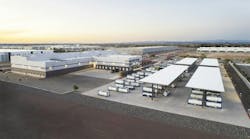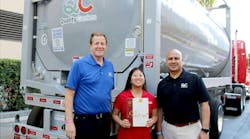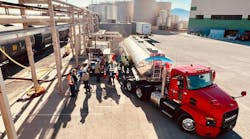THERE are a number of tradeoffs to consider within storage-tank insulation materials, whether they are fiberglass, calcium silicate, mineral wool, cellular glass, perlite, polyisocyanurate, thin blanket, or aerogel, according to Larry Wink, consultant and former chief executive officer of Wink Engineering
“What’s your heat input to the tank systems?” he asked. “What is the thickness of the insulation? What are the costs for all of those going back to the total cost of ownership and lifecycle costs? What are you going to spend for energy input for the heating system? And then the pumping system? You really need to get down to calculations and apply some process engineering to make it a good design.
“You also want to make it robust and flexible. You might store one grade of asphalt at the outset of the design of the project. But you know what? Down the road you might want to store a different product in that tank. So think about other applications. Many terminals are changing out contracts with their customers and want to be able to have the flexibility of using that tank for more than one product.”
In his presentation, “Considerations for Heating Storage Tanks,” delivered during the International Liquid Terminals Association’s 2016 International Operating Conference, Wink analyzed the typical liquid products requiring heating.
Petroleum crude oils (heavy crudes):
• ≤ 20° API (southern US ~ +30° F outdoor temperature). Storage temperature varies. Pump types: centrifugal (C), positive displacement (PD).
• ≤ 20° API (northern US ~ -30° F outdoor temperature). Storage temperature varies. Pump types: C, PD.
• Canadian bitumen (~8°API). Storage temperature: 180° F to 200° F. Pump type: PD.
• Diluted bitumen (~16°-20°API). Storage temperature: 80° F to 90° F. Pump type: PD.
Petroleum distillates and heavy products:
• No. 6 Fuel Oil. 160° F. C & PD.
“I know many terminals in petroleum storage,” he said. “They have centrifugal or positive displacement pumps. There are tradeoffs with each type of pump in terms of viscosity range and temperature. The economic tradeoff is energy cost versus which pump gives you the lower cost alternative. Can you handle a higher viscosity at lower temperatures or do you need to heat the storage tank? “
• Atmospheric Resid. 130° F to 160° F. C.
• Vacuum Resid. 150° F to 180° F. PD.
• Asphalt handling in facilities:
• Fluxuation 150° F to 200° F. C, PD.
“Depending on the characteristics of that asphalt or crude, you could see quite a range of storage temperatures.”
• Road Grade Asphalt (AC 5, 10, 20). 250° F to 325° F. PD.
“You can use a centrifugal pump in many applications. It’s less viscous. It’s a function of what temperature you store it at. But you’ll find yourself using positive displacement pumps quite often in those cases.”
• Roofing Grade Asphalt. 350° F to 400° F. PD.
“After it’s gone through oxidizing, it becomes more viscous. Therefore you need to store it at higher temperatures.”
• Asphaltene. 550° F. PD.
“It’s actually a solid form of material when it’s at ambient temperature conditions, so it’s stored at much higher temperatures. And there are even more significant design considerations when it comes to piping systems and stress analysis.”
• Lube Oils. (Many types/viscosities). Storage temperatures vary. PD.
“Anything in here that’s above 212 degrees—obviously water boils at that. So be sure you don’t have water getting in that product. Everybody knows asphalt and water don’t mix well. It increases your safety risk. So be sure your system has checks and balances in designs to prevent water intrusion in the product.”
He listed the temperature characteristics of a few chemicals and products that he has seen in the past 10 to 20 years:
• Sodium Hydroxide (Caustic), 65° F.
“It will crystallize when it gets too cold, so temperature modulation on it is a milder consideration. You don’t want to let it be stored too hot either. In some cases, you want a system that’s able to maintain temperature to keep the product fluid but at the same time, it can’t be so hot that it causes degradation to the product.”
• Urea, 75° F.
• Phosphoric acid, 95° F.
• Glycerine, 100° F.
• Vegetable oils (many), 100° F to 130° F.
• Fuels, chemical additives, 110° F to 130° F. (Tighter temperature tolerances.)
• Molasses, 130° F to 160° F.
• Glucose, 150° F.
• Firewater, 40° F±.
“No matter what it is, get the material safety data sheet,” he said. “Characteristics can sometimes be a little different than your intuition tells you. Be sure you approach the product with care.
“We work for a customer in Montana. They can see 30 degrees below for extended periods of time. And yes, they do have steam coils in the firefighting water. They learned the hard way. They were careless. They said, ‘We keep the water warm. It’s not that many times throughout the year we need to keep an elevated temperature and keep the heat input so it doesn’t freeze.’ They started having an algae growth problem on the bottom and it actually started corrosion problems in the bottom of the tank. There is such a thing as too much of a good thing. You need to pay attention to certain things that may not occur to you on the outset.
“Most of the heated tanks we come in contact with have boiler systems, so you have steam available. Most often it’s a saturated steam. Sometimes you can have boiler packages where you get a little bit of super heat there. There are heat transfer fluids you can purchase. One of the advantages is they can operate at a very wide range of temperatures and stay fluid themselves and provide the medium. They can be costly but they can also be very effective for certain applications you may need to consider within the overall site.
“We have actually designed something that’s in processing facilities where diesel life cycle oil or an actual refined product distillate can be used as the media itself. You do have to purge it, flush it, and change it at certain intervals it will degrade over time.”
He provides these seven options for pumping circulation circuits and mixing techniques in API 650 tank heating systems:
• Basic internal pipe coils.
• Bayonette/stab-in exchanger. “We have used these more in cases of asphaltene stored over 500 degrees. If ever you have a system that has really viscous material. Let’s also say your system has a problem with steam or oil supply for a period of time and now you have risk if it’s sitting there for a really long time, and you happen to be in a real cold climate area in the winter time. This device will apply heat around the bottom, and therefore you can get the product to flow. It has an inherent advantage for heavier, more viscous materials.”
• External exchanger. “The maintenance advantage of an external shell and tube bundle is it’s all exterior. With that stab-in bundle, you have to take the tank out of service if you have a serious problem. Here, it’s exterior to the system and you have ready access to it.”
• External fired heater. “We’ve installed these on very large crude tanks. You can buy small fire heater package units for a single tank or can put in larger heater system that you can use for multiple storage tanks.”
• External heat tracing (smaller tanks). “We put these in smaller storage tanks—quite often those in chemical-type service. An example is phosphoric acid, where if you don’t want heat on that product for extended periods of time and you have the media itself on the skin of the tubing or whatever that’s maybe on the interior of the tank in contact with that product. You want to make sure it’s circulated well. You can put these external tube wrappings. Quite often there are cement products you can use to get better heat transfer. You’re keeping it out of contact from the product. From a maintenance standpoint, when it comes to the heating system, you would never have to take the tank out of service.”
• Silicon controller rectifier/bayonette stab-in exchanger. “Electrical power bundles that run on thermostat control. It has a tighter temperature control. You can keep it at exactly a certain temperature all the time. It’s especially good for chemical products.”
• Basic internal pipe coils (tempered hot water). “This is another one you can modulate effectively. If you have a steam system throughout the terminal already and have a product that you need to store, you don’t want to expose to that 300-plus degree saturated 150-pound steam, you can put in a three-way valve. This basically becomes a hot water system as opposed to steam on the interior of the tank. With the condensate return, you can take a slipstream off of it. You have to put a pump on it because the condensate pressure is going to be lower than the steam. Then you mix back your warm condensate and then you have a warm-water bath inside that tank. This is for when you have that temperature concern of being too hot in chemicals applications.” ♦









